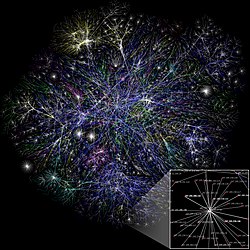
Back Models de grafs aleatoris exponencials Catalan مدلهای گرافی تصادفی نمایی Persian Grafos aleatórios exponenciais Portuguese
Exponential family random graph models (ERGMs) are a set of statistical models used to study the structure and patterns within networks, such as those in social, organizational, or scientific contexts.[1][2] They analyze how connections (edges) form between individuals or entities (nodes) by modeling the likelihood of network features, like clustering or centrality, across diverse examples including knowledge networks,[3] organizational networks,[4] colleague networks,[5] social media networks, networks of scientific collaboration,[6] and more. Part of the exponential family of distributions, ERGMs help researchers understand and predict network behavior in fields ranging from sociology to data science.
| Part of a series on | ||||
| Network science | ||||
|---|---|---|---|---|
| Network types | ||||
| Graphs | ||||
|
||||
| Models | ||||
|
||||
| ||||
- ^ Lusher, Dean; Koskinen, Johan; Robins, Garry (2012). Exponential Random Graph Models for Social Networks: Theory, Methods, and Applications (Structural Analysis in the Social Sciences). doi:10.1017/CBO9780511894701. ISBN 9780521141383. OCLC 1120539699.
- ^ Harris, Jenine K (2014). An introduction to exponential random graph modeling. ISBN 9781452220802. OCLC 870698788.
- ^ Brennecke, Julia; Rank, Olaf (2017-05-01). "The firm's knowledge network and the transfer of advice among corporate inventors—A multilevel network study". Research Policy. 46 (4): 768–783. doi:10.1016/j.respol.2017.02.002. ISSN 0048-7333.
- ^ Harris, Jenine K (2013). "Communication Ties Across the National Network of Local Health Departments". AMEPRE American Journal of Preventive Medicine. 44 (3): 247–253. doi:10.1016/j.amepre.2012.10.028. ISSN 0749-3797. OCLC 4937103196. PMID 23415121.
- ^ Brennecke, Julia (2019). "Dissonant Ties in Intraorganizational Networks: Why Individuals Seek Problem-Solving Assistance from Difficult Colleagues". AMJ Academy of Management Journal. ISSN 0001-4273. OCLC 8163488129.
- ^ Harris, Jenine K; Luke, Douglas A; Shelton, Sarah C; Zuckerman, Rachael B (2009). "Forty Years of Secondhand Smoke Research. The Gap Between Discovery and Delivery". American Journal of Preventive Medicine. 36 (6): 538–548. doi:10.1016/j.amepre.2009.01.039. ISSN 0749-3797. OCLC 6980180781. PMID 19372026.
© MMXXIII Rich X Search. We shall prevail. All rights reserved. Rich X Search
